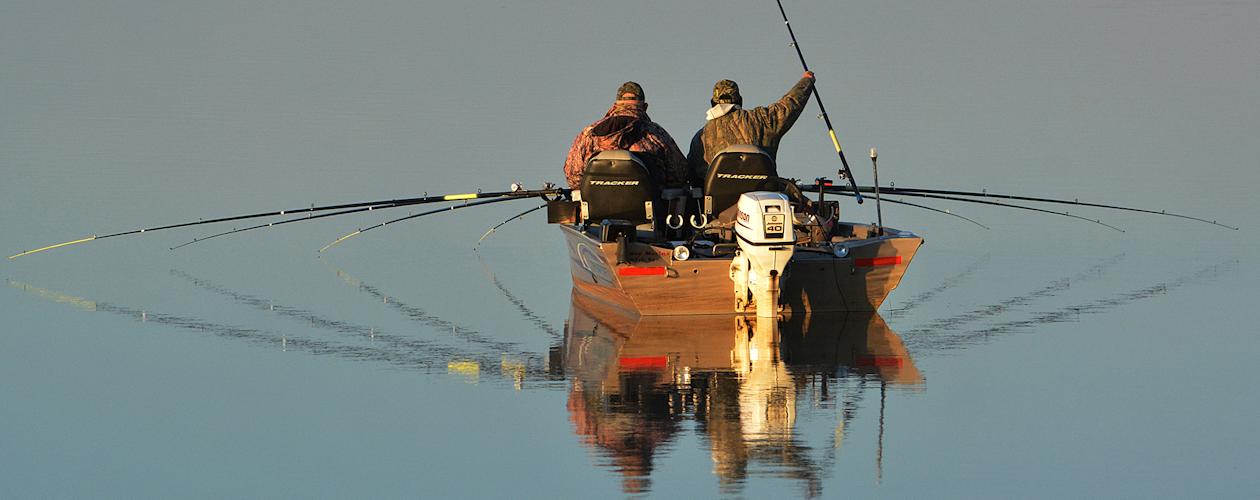Mayfly Hatches Begin; Bass on Main Lake Ledges
Written by Steve McCadams - Published on June 7, 2023
Out of nowhere they appear without making a sound. Often under the cover of darkness they emerge in big numbers and by daylight willow trees and all sorts of limbs and bushes weigh heavy with their presence.
It’s mayfly time across Kentucky Lake. This natural phenomenon is something to behold. Practically every fish that swims the waters benefits in some form from a massive mayfly hatch.
The first hatch of the year appeared over a week ago and anglers can expect repeat performances for the next several weeks (and months) along the main river shorelines and island rims. Sometimes they hatch all over the lake and cover the backs of bays too even though the areas are far away from the main river channel currents.
Often referred to as Mother Nature’s buffet, the millions of mayflies signal the start of summer in many respects although the official start of summer doesn’t arrive on the calendar until June 21 this year.
Practically all species dine on the abundant food source once it starts arriving. Even before the adult fly takes flight and clings to low overhanging branches on the riverbanks it serves as a food source. The larva stage emerges from the lake bottom before adult flies can be seen and fish often gorge themselves on the submerged feast.
Once the adult flies emerge in an awkward flight their life span is short---sometimes living only a day or so. Yet in that short lifespan birds feed on them and bounce along the limbs helping displace clinging flies that fall to the lake surface.
A few twitches on the water signals their whereabouts to hungry fish and within the blink of an eye they disappear in a swishing swirl. Competition is underway from aggressive bluegill, bass, yellow bass, sunfish and multiple number of species that have headed shallow to partake of the seasonal feast.
Fishermen along Kentucky Lake can expect some big hatches in the weeks ahead. Some of the more massive hatches occur throughout June and July and begin to taper off as summer matures. A few will still be seen hatching in August and September but by late September mayfly hatches around this part of the country are gone but not forgotten.
So it’s a short honeymoon with mayflies. Even though their lifespan is short too, they’re here long enough to make quite an influence on the fishing scene.
Sometimes anglers fishing at night for white bass or crappie near the main river channel or around bridge piers where current is present will see the flies begin to hatch and swarm near their lights.
Others fishing by day may leave the lake the afternoon before with no flies present only to return and discover a massive hatch has occurred overnight. By daylight they appear, hanging by the thousands from docks, piers, trees and anything else they can cling to for a short stay.
Anglers can take advantage of this mystical occurrence by casting flyrods with popping bugs and slow sinking nymps. It can be fast and furious. Bluegill, bass and assorted sunfish will rise to the occasion and provide a thrill.
Tossing an ultralight spinning rod with small grubs or beetle spin type lures can be deadly as well. Also productive is a slip bobber style presentation using crickets for bait. Be prepared to do a lot of rebaiting!
Mayfly hatches sometimes upset the applecart for crappie and bass fishermen for a few days as this instant food source spread all over the lake can be tough competition. After a few days the fish slowly resume a shad based diet and return to their usual forage base but the mayfly hatch definitely changes the mood across the reservoir for a few days.
Now is the time to keep a sharp eye out for mayfly hatches. It’s tough to predict just when one will occur but usually the word gets out quickly among the ranks of fishermen.
Take advantage of this fishing phenomenon in the weeks and months ahead and you might find some of your youth while in the midst of a fishing frenzy. Take a youngster too and show them this unique moment of nature as she provides for her critters.
THIS WEEK’S UPDATE
Meanwhile, lake conditions this week are similar to last week in terms of elevation and surface temp. The reservoir is resting around the 359.3 mark in the Kentucky Dam sector and elsewhere on the reservoir. Normal summer pool is 359.
Surface temperatures had warmed up a bit due to last week’s and most of this week’s hot weather. Readings were in starting out the mornings around 79 degrees and climbing to 82 by midday. Water color remain clear across the reservoir and the area is in need of some rain.
The region should get a little break in the hot weather for the next several days according to the weathermen.
Current has diminished this week since no runoff has entered the Tennessee River. That curtails activity for catfishermen attempting to search the main river channel areas in hopes of locating meandering fish in hot pursuit of balls of baitfish.
The catfish bite has been sluggish. Once some current returns that will improve and some days the flow increases by midday day or later afternoon when TVA is pulling water through Kentucky Dam.
Some crappie anglers working midrange depths of 12 to 18 feet have been tying into a catfish now and then. When current resumes it will pull more catfish to the main river bank areas as they will follow their forage, namely threadfin shad.
Bluegill anglers have seen activity diminish around bedding areas as of late. The fish are moving toward steeper shoreline banks in pursuit of mayfly hatches now underway.
Bass activity has improved on main lake ledges recently and the summer pattern of hitting the humps and drop-offs has been productive. However, ledge fishing has some similarities to catfishing this time of year in that both type anglers thrive on some current.
Without current the shad don’t move around as much and roam in their pursuit of plankton that’s moving in the water column when flowing water is present. Both bass and catfishermen believe in the slogan: the current giveth and it taketh away!
Popular now are the wide variety of big deep diving cranks baits in assorted colors. Shad colored variations are the most popular but sometimes in clear water some unique colors attract a reaction strike from sluggish bass.
On the deck of most bass anglers will be several rods this time of year. Odds are a couple different colored crankbaits will be on the menu plus big Texas rigged worms and perhaps a Carolina rig to slowly crawl over the sandbars.
Also in the arsenal will likely be a swim bait of some sorts plus a jig and pig combo or hair jig for hopping along the ledges. It’s time for small schools of pin minnows to appear in shallow grassbeds and around main river island rims where blowdown trees are attracting them.
As the newly hatched fry emerge there’s usually a shallow pattern for bassers who love to toss a spinnerbait or some topwater jerk baits and buzz baits. Even in the hot weather there’s always some bass activity around islands and shallow weeds if schools of the small bait fish are present.
Crappie have been fair for a few fishermen hitting the lake in the early morning hours in an attempt to beat the heat. Most are targeting the 12 to 18 foot depth range using both minnows and jigs.
Stakebeds and brushpiles are holding a few fish but they have been somewhat finicky for most anglers. Battling the abundant mayfly hatches can be a high hurdle at times as the fish gorge themselves on the mayfly larva as it emerges from the lake bottom.
After a few days the crappie bite usually resumes but at times the sudden food source is so abundant the crappie have a mood swing and show little interest in taking a jig or minnow.
Trolling crankbaits can produce an assorted catch of crappie and catfish this time of year too. Covering a lot of water as boaters pull crankbaits over the top of main lake sandbars will pay dividends. You’ll lose a few crankbaits to the submerged obstacles but that’s the cost of admission when using this technique.
< Return to the Archives
< Return to Fishing Reports
< Return to Fishing Overview








